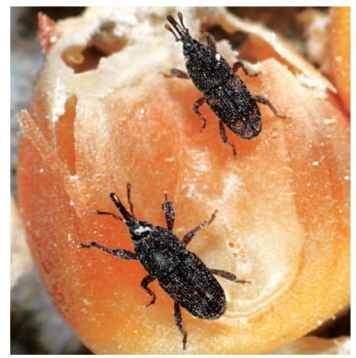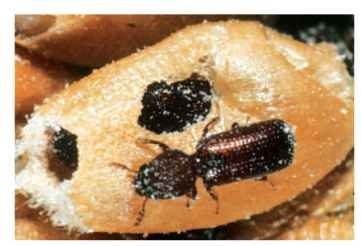Stored Products as Habitats
The protection of stored food against attack by insects and molds has been a necessity since the dawn of agriculture, or perhaps since humans began to manufacture primitive clothing and tools for daily use from plant or animal material. Protection of stored products, thus, has a tradition of tens of thousands of years and is documented in the earliest records of history.
Stored food and other products of plant or animal origin provide a habitat with shelter, food, and breeding sites for insects (Fig. 1). Worldwide losses from these postharvest insects and other food pests are estimated to be from a few percent in developed countries to 20% in an average year in some developing countries. Under certain storage conditions, 50-100% of food is lost.

FIGURE 1 Traditional storage facility for grain in China.
Several hundred insect species are associated with stored products. Most are beetles (Coleoptera) or moths (Lepidoptera), with their parasitoids being wasps (Hymenoptera). However, there are only about 100 species of economic importance. These can be divided into two main categories: species infesting dry botanicals, mainly but not exclusively grain seeds and their products, and scavenger species infesting animal products (meat, furs, wool, feathers, etc.). Very few pest insects can feed and breed successfully on both plant and animal material.
ECOLOGY OF STORED-PRODUCT INSECTS
The storage environment can be regarded as a human-made, simply structured, unstable ecosystem. All trophic levels of a typical ecosystem are represented. However, the system is not self-sustaining, and there is a unidirectional flow of energy and biomass.
Trophic Levels in a Storage Environment
The harvested and stored parts of the plants or the processed material are regarded as the producers (or the first trophic level) and contain the energy that was captured by the crops in the field. The primary consumers of the second trophic level in stored cereals are insects that infest the intact grain kernel. Most numerically dominant are the grain weevils of the genus Sitophilus (Curculionidae) (Fig. 2), the grain borers Rhyzopertha dominica ( Fig. 3 ) and Prostephanus truncatus (Bostrichidae), and the grain moth Sitotroga cerealella (Gelechiidae). Primary consumers provide routes of entry for secondary consumers, such as Tribolium spp., that feed on the waste

FIGURE 2 Sitophilus zeamais, maize weevil, adults on maize.

FIGURE 3 Rhyzopertha dominica, lesser grain borer, adults on wheat.
products or on debris, the frass, provided by the primary consumers. However, because damaged grain and grain dust are always present, secondary consumers can also exist without primary consumers.
The oxidation processes of the stored commodity and the respiratory activity of primary and secondary consumers generate heat and moisture that affect the microclimate. ” Hot spots ” may occur, which favor microbial growth. Certain microbial fungi further enhance conditions favorable to primary and secondary consumers. At this stage secondary and tertiary consumers become difficult to separate. Finally, the way is paved for the third trophic level of decomposing fungi, yeasts, and bacteria.
Predators and parasitoids of stored product insects are frequently encountered in highly infested commodities. Some of them are very closely associated with prey or host. Others are less specific: most parasitic wasps, for example, parasitize a number of different host species.
Carnivorous or scavenger species are typically found on stored commodities of animal origin such as dry meat or fish, wool, hair, and furs or products made out of these such as clothing or carpets. For example, dermestid beetles of the genera Dermestes, Anthrenus, Attagenus, or Trogoderma and the tineid moths Tineola bisselliella and Tinea pellionella are the most common insects in households. Scavengers feed on dead insect parts as well, which is why they are often found in stored products of plant origin that are infested with phytophagous insects.
Because of the weblike interactions of the different trophic levels, it is difficult to place insect species in specific categories. Their roles may be granivore, carnivore, fungivore, predator, parasite, and scavenger. These roles, together with the microflora and the environmental factors temperature and humidity, result in ongoing fluctuations of physical parameters, species succession, changes in population densities, and continuous degradation of the stored commodity.
Feeding Habits and Damage
Primary and secondary insect pests of stored foodstuff are poly-phagous, with a general preference for either dry plant material or material of animal origin. Under a different perspective, these pests can also be classified into internal and external feeders. Internal feeders are species that penetrate the intact outer coating of seeds either as feeding or ovipositing adults or as freshly hatched larvae. External feeders graze on the surface of stored foodstuff, on already damaged material, and on debris. Nevertheless, they almost all have a cryptic feeding habit that is probably a result of their negative phototaxis. The larvae of the Indian meal moth, Plodia interpunctella, the most common stored-product moth worldwide and also frequently encountered in households, prefers undisturbed and darker places wherever suitable food is available.
The most obvious damage caused by stored-product insects is the destruction of food destined for human consumption. In addition to their capability to cause tremendous losses, insects contaminate the commodity with frass, feces, exuviae, and corpses. The accumulation of filth may lead to the rejection of the stored material. Except for some tenebrionid grain beetles infected with a certain tapeworm, stored-product insects have not been shown to transmit human pathogens or diseases. However, some of their by-products can be highly allergenic to humans.
Environmental Factors
Temperature and relative humidity usually determine the limits of insect infestations in stored products. The range of temperature in which stored-product insects are active lies between 8 and 41°C. Reproduction and larval development above or below these limits are not possible, and the individuals can survive extremes only in diapausing or hibernation stages. Some species are more cold-hardy or heat tolerant than others. Relative humidity also is important because it directly influences the moisture content of the foodstuff. The relative humidities to which pest insects have adapted range from near 0 to close to 100%, with typical optimal conditions being from 60 to 75%. Temperature and relative humidity of the microclimate can be actively influenced through the metabolic activity of aggregated individuals. Light is less important than temperature and humidity as a factor influencing the survival of stored-product insects. However, most larvae have a negative phototaxis and therefore are most likely to be found in dark, less disturbed areas.
BEHAVIOR OF STORED-PRODUCT INSECTS
In addition to physical parameters, the behavior of stored-product insects is greatly influenced by semiochemicals. Living organisms, grain, microflora, insects, and mites, as well as decaying matter, produce an array of volatiles that combine with the oxygen, nitrogen, and carbon dioxide of the system. For example, enzymatic reactions in stored seeds produce unsaturated fatty acids that are highly attractive to a number of pests. Catabolism of decaying plant and animal matter enables pest insects to locate suitable feeding and breeding sites. Fungi have a distinct odor that is attractive to fungivorous species but repellent to others at high concentrations.
Intra- and interspecific communication is directed by a number of pheromones and allelochemicals. For example, spacing and oviposi-tion pheromones are found among bruchids marking already infested seeds. These compounds are repellent to conspecifics. Spacing phe-romones of certain species not only act on conspecifics but also repel nonconspecifics and thus act as allomones.
Sex pheromones, nearly always produced by the female, attract mates. These pheromones comprise specific compounds or a highly specific combination of compounds. Aggregation pheromones, typically found in species with long-lived adults, are produced by males and attract conspecifics of both sexes. Certain compounds of some aggregation pheromones are not species specific, and there is cross-attraction, especially among closely related species. In most cases, foods synergize the effect of aggregation pheromones. Although aggregation pheromones increase the likelihood that an individual will find a mate among aggregated conspecifics, the role of these substances as mating pheromones is not necessarily obvious.
Several parasitoids and predators make use of volatiles to locate hosts and/or prey, and under certain circumstances pheromone components may act as allelochemicals. Specialists that parasitize or prey on a single host species, a very narrow range of related host species, or specific developmental stages are attracted to specific kairomones emitted by their host or prey.
ORIGIN OF STORED-PRODUCT INSECTS
The origin of stored-product insects can be examined from three viewpoints: first, from a practical or physical point of view, asking for the natural reservoirs from which the insects spread into the storage system and seeking to learn how they invade a particular commodity; second, from a phylogenetic point of view, examining the ecological and behavioral preadaptations that made it possible for insects to shift from an original or primary habitat to a relatively recent, human-made habitat; and finally, from a historical point of view, searching for the geographic origins of the various insect species that infest stored commodities, which today are considered to be distributed worldwide.
Preadaptations and Natural Habitats
Insect species capable of surviving in stored commodities generally have some biological strategies in common. Species infesting stored products are not monophagous; rather, stored-product insects are food opportunists. For example, the cigarette beetle, Lasioderma serricorne, and the drugstore beetle, Stegobium paniceum, are perhaps the most ubiquitous of all stored-product pests, but all others also feed and breed on a variety of products. Almost all species found in human-made storage systems also can be found outdoors.
Natural breeding sites of stored-product insects can be sheltered niches where seeds and nesting material were gathered by rodents, birds, or other insects. Dermestids, ptinids (spider beetles), and tineids (clothes moths) are frequently found in empty rodent or bird nests where they feed on hairs, feathers, feces, pellets regurgitated by birds of prey, and food debris brought in or left by the previous occupants. Carrion is a food source as well for some species.
Stored-product insects typically have the ability to survive a long time without food. When environmental conditions are favorable and resources are available, stored-product insects reproduce over prolonged periods and have a rapid population growth rate, exploiting resources maximally. Dispersal is regulated by population density, and most stored-product insects are good fliers, which is essential for locating patchily distributed food and breeding habitats. Therefore, the following preadaptations help insect species to exploit the resources of stored-product systems: a range of natural reservoirs, a range of food habits, ability to survive in the absence of food, a wide range of tolerance for physical factors in the environment, and a high reproductive rate at optimal conditions.
Additionally important for consumers of dry foodstuffs is the ability to conserve water. Pest insects have to be either tolerant of low humidity and moisture content, able to recycle metabolic water, or able to influence and alter microclimatic conditions. Several species, in which the adults feed, tend to aggregate at spots suitable for feeding and breeding. Such aggregation is not incidental but a result of male-produced pheromones that are attractive to conspecific males and females. This behavior raises the question of the evolutionary advantage for males producing pheromone that attracts not only potential mates (conspecific females) but also potential competitors (conspecific males). It is thought that male-produced aggregation pheromones originally served to attract a mate. If this is correct, the use of the phe-romone by other males of the same species then evolved secondarily, presumably allowing them to locate resources and assembled females. This would result in a fitness gain only for the intruding males.
An alternative explanation for the production of aggregation pheromones could be that the primary role of the male-produced aggregation pheromone was to attract and congregate conspecifics to overcome host defenses or unsuitable climatic conditions. Because males and females can serve equally well in this respect, the phe-romone emitter benefits from attracting beetles of either sex.
To infest dry foodstuffs or stored commodities successfully, stored-product beetles certainly do not have to overcome host defense systems. However, in natural habitats, such as under bark or in wood, stored-product beetles most likely benefit from, and rely on, aggregation pheromones to weaken the host and make the habitat more suitable. This behavior can be observed in non-stored-product species closely related to postharvest pests in the Tenebrionidae, Curculionidae, and Bostrichidae, which partly feed and breed on physiologically active host plant parts. Where seeds and other harvested products are usually stored under low temperatures and rather dry conditions, the aggregation pheromones may serve to congregate groups that alter the microclimate. Such areas of higher temperatures and humidity may provide favorable conditions for insect development.
Not all insects that infest dry foodstuff have aggregation pherom-ones. In those that do not, there is a tendency of the larvae to aggregate. For many species, development is maximized at an optimal density of individuals. Individual fitness declines as the population shrinks or enlarges. For example, the eggs of many bruchids are deposited in clutches. Ovipositing females in the pyralids are guided to breeding sites by mandibular gland secretions produced by conspecific larvae. (A larval pheromone from mandibular glands is responsible for an optimal spacing, thus regulating population density.) Many aggregation pheromones also serve as guides to ovipositing females.
Temporary Changes in Habitats
The evolutionary origin of most stored-product insects remains speculative. However, autecological studies indicate a more or less xylophilous origin, under bark or in decaying wood, for most species. Omnivorous and partly predatory feeding habits could have allowed those species to invade animal nests in the same habitat or close by. These nests and the materials within could have provided good sources of otherwise scarce carbohydrate- and protein-enriched resources. In the same way, at the beginning of agriculture more than 10,000 years ago, insects could have gained access to storage bins in granaries constructed of infested timber. This kind of behavior can be observed in Prostephanus truncatus, the larger grain borer, which can survive in a variety of wooden building materials often used for simple granaries in tropical and subtropical countries. When the new harvest is brought in, this beetle readily invades the stored commodity, returning to its xylophilous habit when the alternative enriched food source declines. Other insect pests associated with stored products also frequently commute between the stored commodity and their cryptic life in cracks and crevices of the storage facility, where they feed on debris.
Geographic Origin and Worldwide Distribution
Today most stored-product insects are worldwide in distribution, and it is difficult to trace species to specific geographic origins with certainty. Global trade of food and other commodities, and the past lack of quarantine regulations, dispersed most storage pests with the products they had infested. Despite their cosmopolitan distribution, not all storage insects are established worldwide or occur outside warehouses or granaries. This is especially true in the colder parts of the world. Callosobruchus maculatus, for example, does not survive winters in the Northern Hemisphere unless inside heated storage facilities. For some species it is impossible for climatic reasons to successfully survive as nonsynanthropic populations.
The association of certain insects with humans most likely began in prehistoric times, probably contemporaneous with intensified agriculture and the domestication of animals. Phylogenetic, ecological, and historical evidence suggests that the majority of stored-product insects originated in the tropical and subtropical parts of the world. These centers of origin were also the centers of Neolithic agriculture.
PROTECTING STORED PRODUCTS AGAINST PEST INSECTS
Some of the most modern approaches to keeping stored food from spoiling are based on historical and traditional methods modified by today’s technology. The storage of commodities under low oxygen atmospheres, to slow down the biological decay mechanisms, was in principle already used in ancient underground and hermetically sealed storage facilities of the Old World. The same effect occurs in modern grain facilities that are fumigated with modified atmospheres enriched with nitrogen and carbon dioxide. The ancient Egyptians intermixed ash with grain, which acted as abrasives on insects’ cuticle, causing desiccation. Today, inert dusts on a base of diatoms are applied, and by a slightly different mode of action these additives cause the insects to desiccate. The Egyptians added specific herbs and spices to the commodities to repel pest insects. Sulfur was one of the first fumigants for stored product protection. The insecticidal property of burning sulfur was known in the New Kingdom around 1000 b.c. Toxic fumigants have the great advantage over contact insecticides of fully penetrating the commodity and therefore also killing internal infestations. However, the application of fumigants and pesticides is not risk free. Environmental concerns and the potential danger to human health have led to a steady reduction of registered fumigants and contact insecticides. Incorrect handling of pesticides can lead to control failures and resistance.
In the past, eradication of pests was the primary objective, and increasingly high food quality standards allow no, or only little, contamination of stored commodities. On the other hand, consumers demand foodstuff that is free of chemical residues. A zero pest tolerance, however, can rarely be achieved without the application of insecticides. Today’s pest control programs must therefore address health-related, ecological, and economic concerns. Modern pest control strategies in stored product protection focus on integrated pest management (IPM). The concept of IPM is based on using threshold levels to make control decisions and on the combination of physical, biological, and chemical pest control measures. One threshold level, the economic injury level, is defined as the pest infestation level at which the loss due to pests is equal to the costs of available control measures. The threshold is not a fixed parameter, but varies with the control options, the infested commodity, and the infesting pest species. Fundamental requirements for a successful application of an IPM program are detailed understanding of the mode of action of any control measure and specific knowledge of the pest’s biology.
